OK guys, for those of you that have been waiting for it, here's a little tutorial on how I weathered my Hetzer. I got MOST of the steps the only thing I really missed was the last aplication of powders on the wheels. For those of you interested in the finish of the wheels, there was a previous thread that I'm sure you could find in the "search" engine of this forum.
Well, lets get to it:
The first photo shows the application of the base coat. The already-painted-and-weathered wheels /tracks have been masked with low-tack masking tape. You'll notice that it's a fairly light tan,,,I mix Tamiya Dk Yellow with Tamiya White in about a 40/60 mix, and then further tint it with Tamiya Buff til it looks right. I have no "standard formula". There has been some discussions about the "correct" shade of Dunklegelb on nearly every site I've been on, and I can only say that I'm a pupil of the "scale distortion" school of thought, first propounded by Tony Greenland in his amazing book. Basically the argument is that light disperses differently on a small object than it does on a large one, so in order to achieve correct color hues, you need to lighten paint in order to achieve the same tint that that color would have in real life. I have found this to be true; a lot of armor that I see painted straight-from-the-bottle looks, IMHO, too dark, too "yellow". Photographic evidence also seems to point us in that direction.Color photos of the Tiger II, Elefant and Jagdtiger at Aberdeen taken just after their capture show drastically faded base coats of near-tan hues.
I have also learned through trial-n-error that the lighter shadeis necessary in order to assure that the weathering process of washing with raw umber oil does not further darken the finish beyond what would be acceptable.
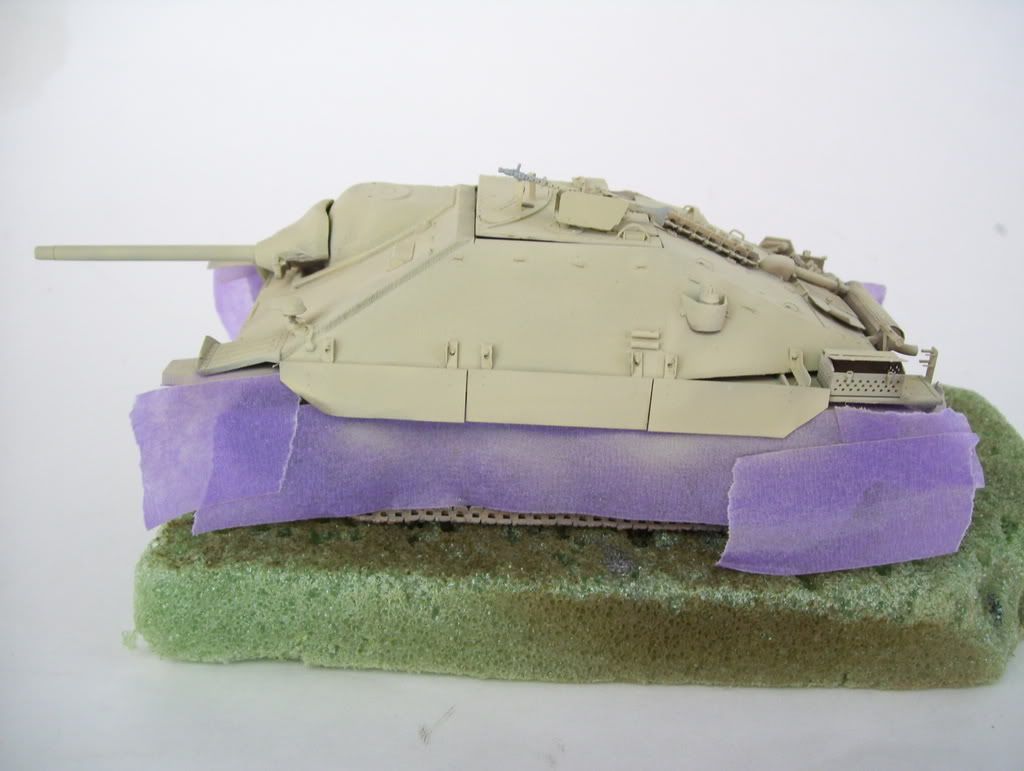
The tortoise-shell pattern was added with unlightened Model Master acrylic Panzer Green...
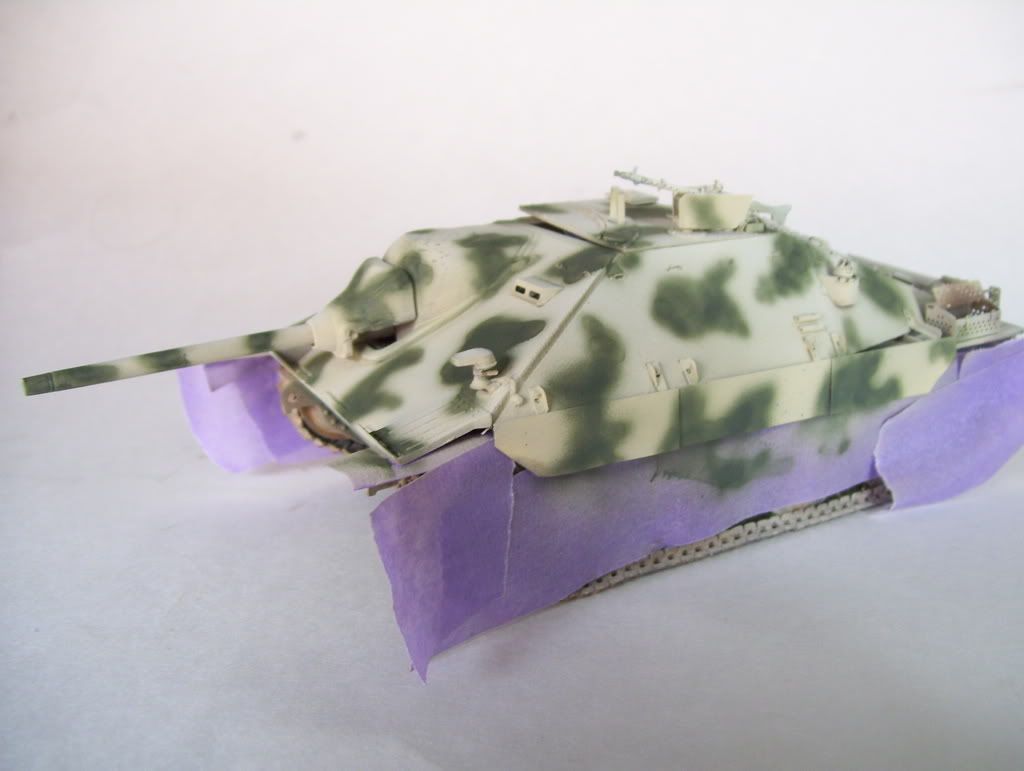
Then, Tamiya Red Brown was used to outline the blotches...
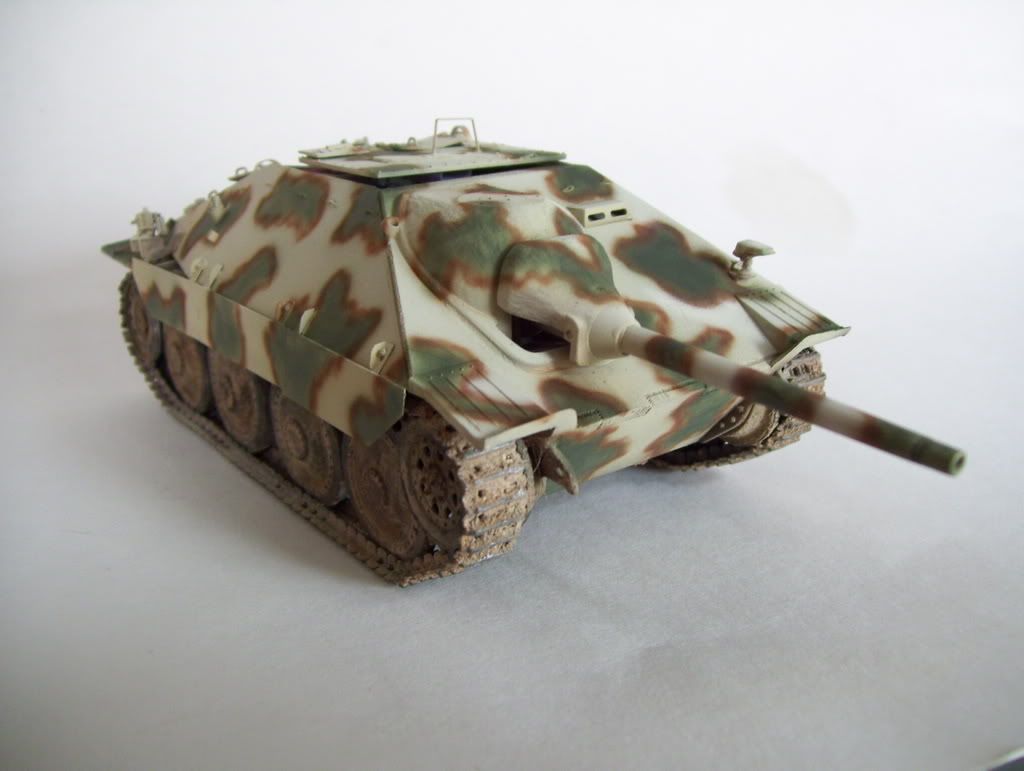
At this point, I carefully cut out the balkenkreuz decal with a razor blade and aplied it directly to the side of the model, snuggling it down with Micro Sol. I didn't feel the need to apply a gloss coat beneath it, as there would be no decal film to tempt with "silvering". Note to "newbies"--if I had put number decals on this tank, I woud MOST DEFINITELY have shot a spot of enamel gloss through my airbrush to lay the decals on; nothing's worse than that dreaded decal "silvering"!. I am not an advocate of "future", the product that so many modelers seem to love and use quite liberally in the modelling world...I think it's difficult to get the model back to an adequate "flat" shade without adding yet another coat or two of dullcoat, and, over time, all those coats of laquer are eventually going to age and yellow, changing the appearance of the finish. So, despite the "hype" about it, I opt out. ![Whistling [:-^]](/emoticons/icon_smile_whistling.gif) No disrespect to proponents of it intended!
No disrespect to proponents of it intended!
When I apply the decal, I take a small swatch of facial tissue, ball it up, soak it, tip the top of the Micro Sol bottle against it to soak it, and press that down against the decal to snuggle it down against the model. This works especailly well over odd details and curves!
When the decal was dry, I did two standard washes with Windsor and Newton oils using regular mineral spirit. I have to credit our friend "biffa" with giving me the idea to apply a dunklegelb/tan wash, which I simply mixed using raw umber/white/yellow (only a pinprick of yellow!!) in order to age the camo a bit. (THANKS RON!) When that was dry, I then did a complete detail/pin wash using raw umber, outlining all the details with a small brush.
In the next photo you can see the "cloudiness" of the tan wash in the blotches. Also, notice that I then took a thin brush and, using the same Panzer Green acrylic, I painted a bunch of superficial "scratches" into the blotches. I also added some orange/burnt sienna streaks/dots by putting a tiny dot of paint where it's origin would be and then, with a wider brush dipped in thinner, "pull" the paint down several times until it's what you want. You can use that very same brush to just poke and stab at the model to transfer that same diluted paint onto the model and make rusty blotches and spots.
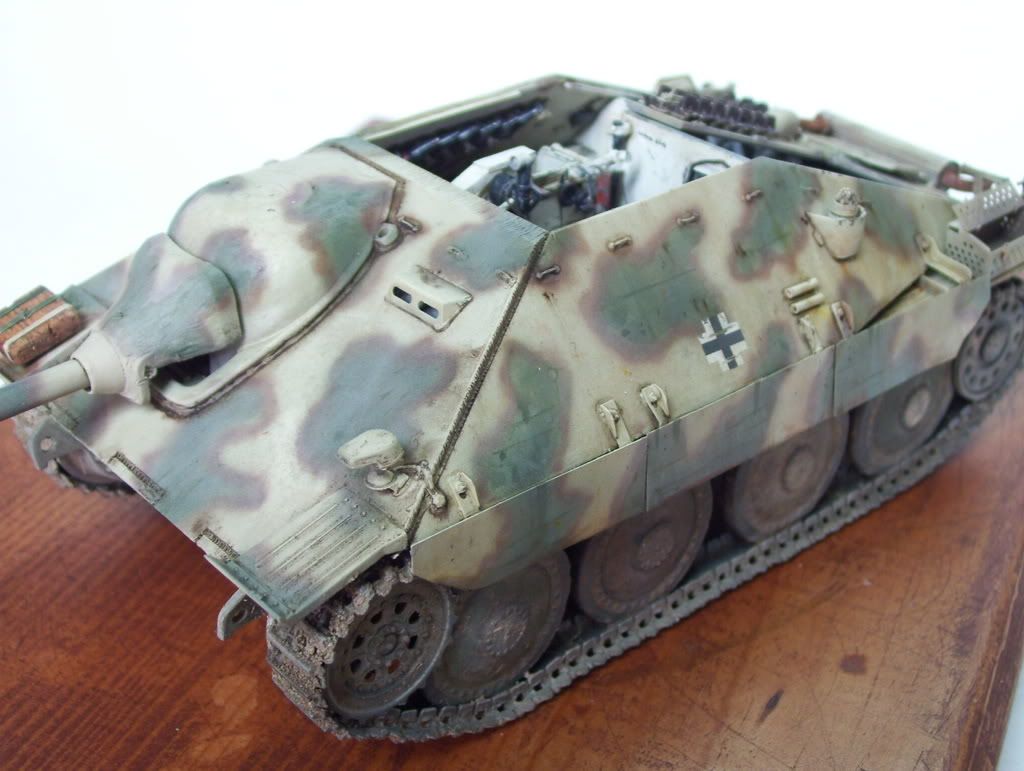
OK, now the fun REALLY begins!![Big Smile [:D]](/emoticons/icon_smile_big.gif) After sealing the model with some rattle-can dullcaot and letting dry overnight, I set about doing the "dot" step. You may have seen biffa talk about and use this method as well, Althoug I'd like to give him credit for teaching it to me, I actually learned this first from the AMAZING tutorial by several of the outstanding Spanish modelers in ARMOR magazine, available through Squadron.
After sealing the model with some rattle-can dullcaot and letting dry overnight, I set about doing the "dot" step. You may have seen biffa talk about and use this method as well, Althoug I'd like to give him credit for teaching it to me, I actually learned this first from the AMAZING tutorial by several of the outstanding Spanish modelers in ARMOR magazine, available through Squadron.
Here's what you do:prepare a small palette-a plastic lid-with paint dollops of oil paints--the more colors the better EXCEPT FOR BLACK(!!!)--and then, using a small brush, put random "dots" of paint all over your model. Do one area or panel at a time! (use black pastel for ant "blackened" areas such as the exhaust; it's way more subtle!)
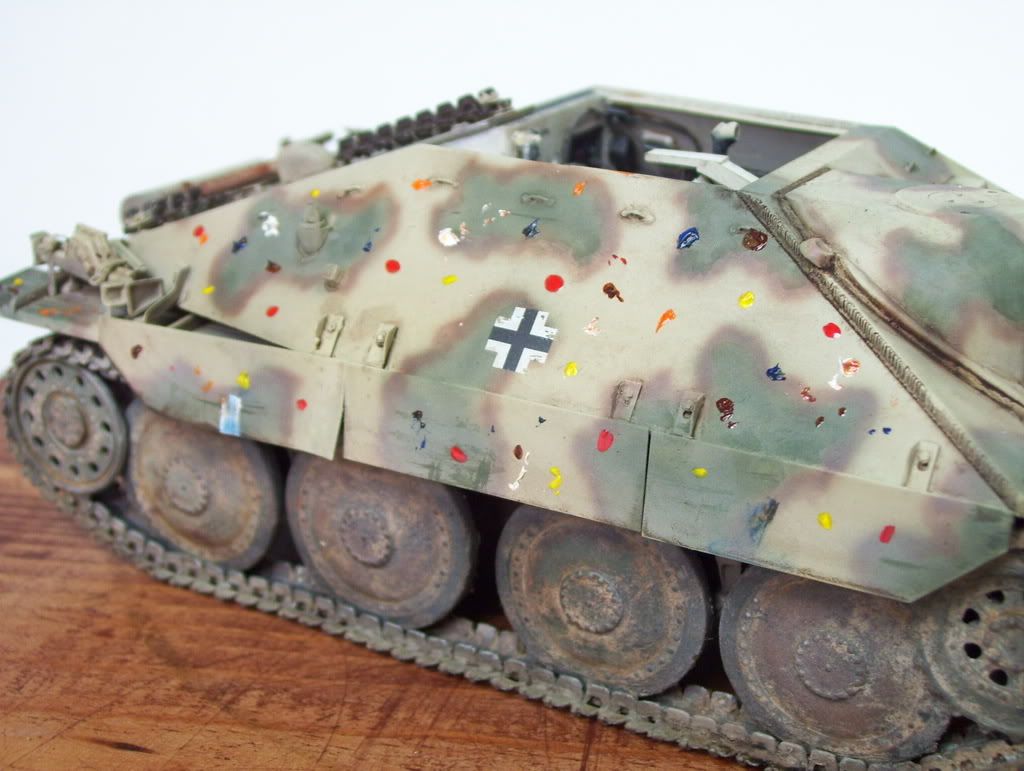
OHHH! DON'T BE SKEERED! ![Laugh [(-D]](/emoticons/icon_smile_newlaugh.gif) Then, using a thinner-soaked brush, start wiping up and down with the brush, liberally smearing the paint. Don't be afraid to clean and re-wet the brush from time to time. You want to really just about wipe the paint away--but not ALL, really!...
Then, using a thinner-soaked brush, start wiping up and down with the brush, liberally smearing the paint. Don't be afraid to clean and re-wet the brush from time to time. You want to really just about wipe the paint away--but not ALL, really!...

BRRRAP!! That's the sound of my brush here, wide-open! ![Laugh [(-D]](/emoticons/icon_smile_newlaugh.gif) Just swab the paint vigorously, til it starts to disappear...
Just swab the paint vigorously, til it starts to disappear...
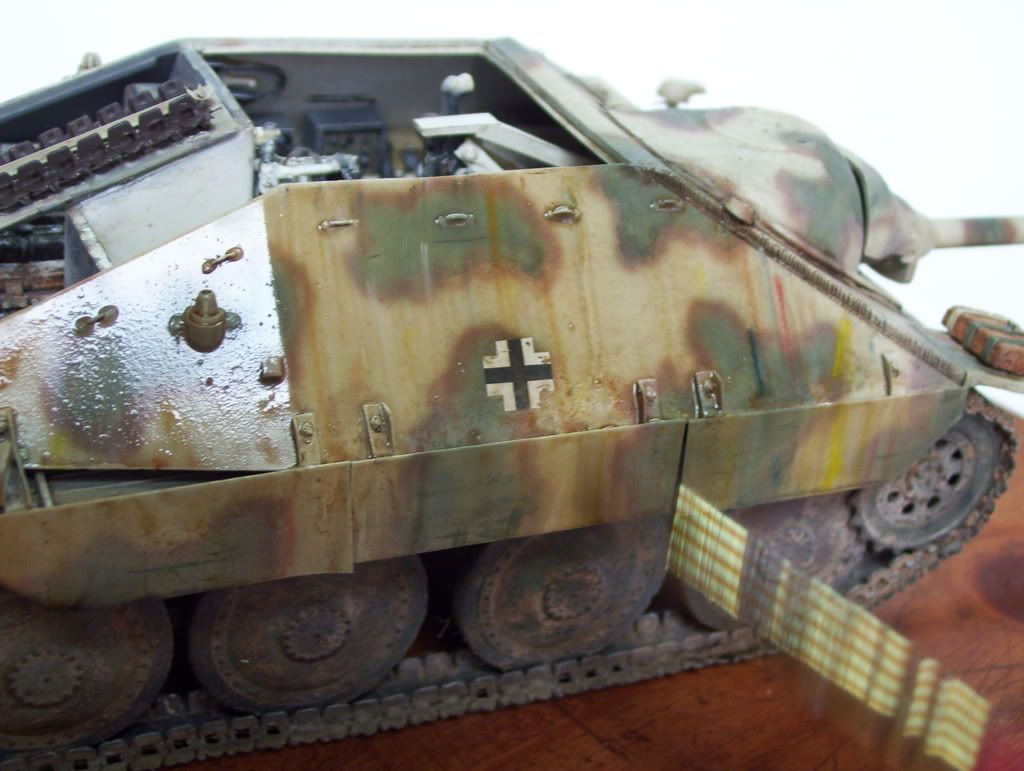
Then, take a ball of facial tissue and blot away the excess thinner...
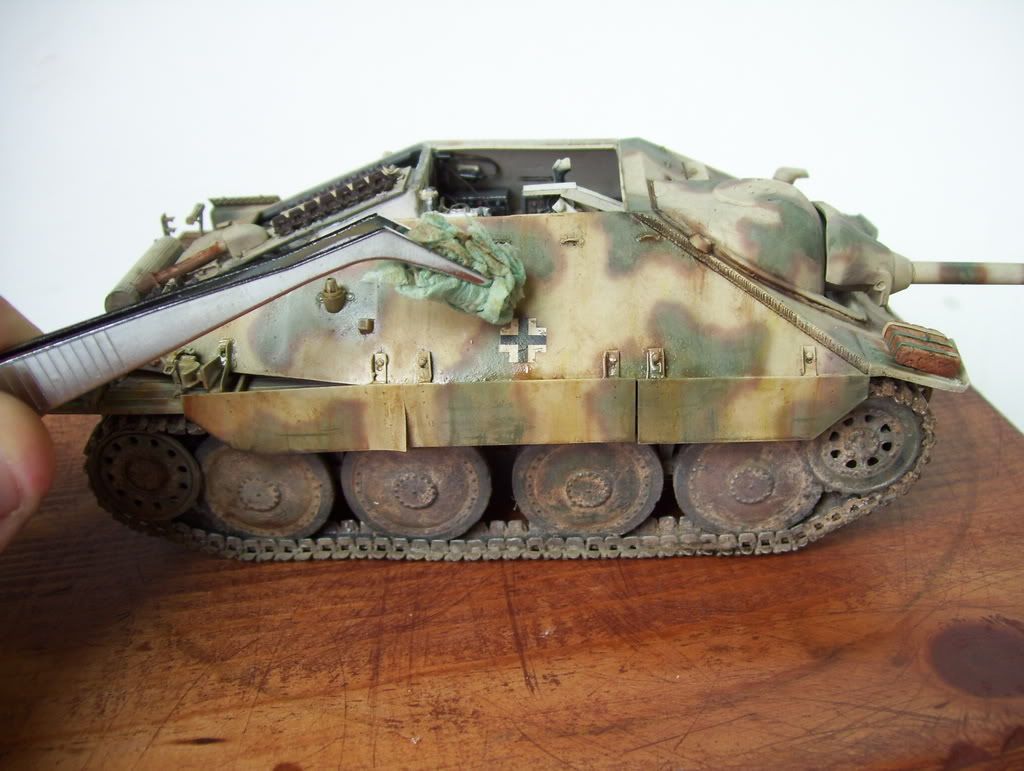
Here you can see the difference between the finished hull, and the top roof which still has to be done...
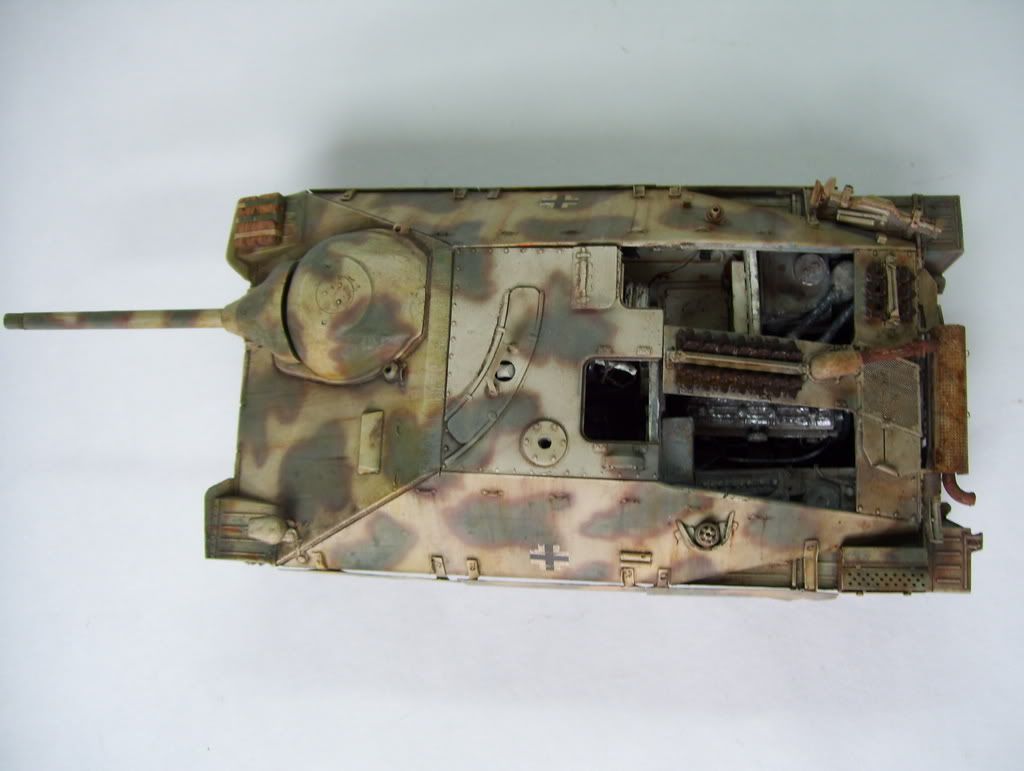
After that had dried, I used some "tan" mixed oil and applied "dusty" streaks and "scratches", as well as some more Panzer Green superficial "scratches"....you can realy see them on the skirts...
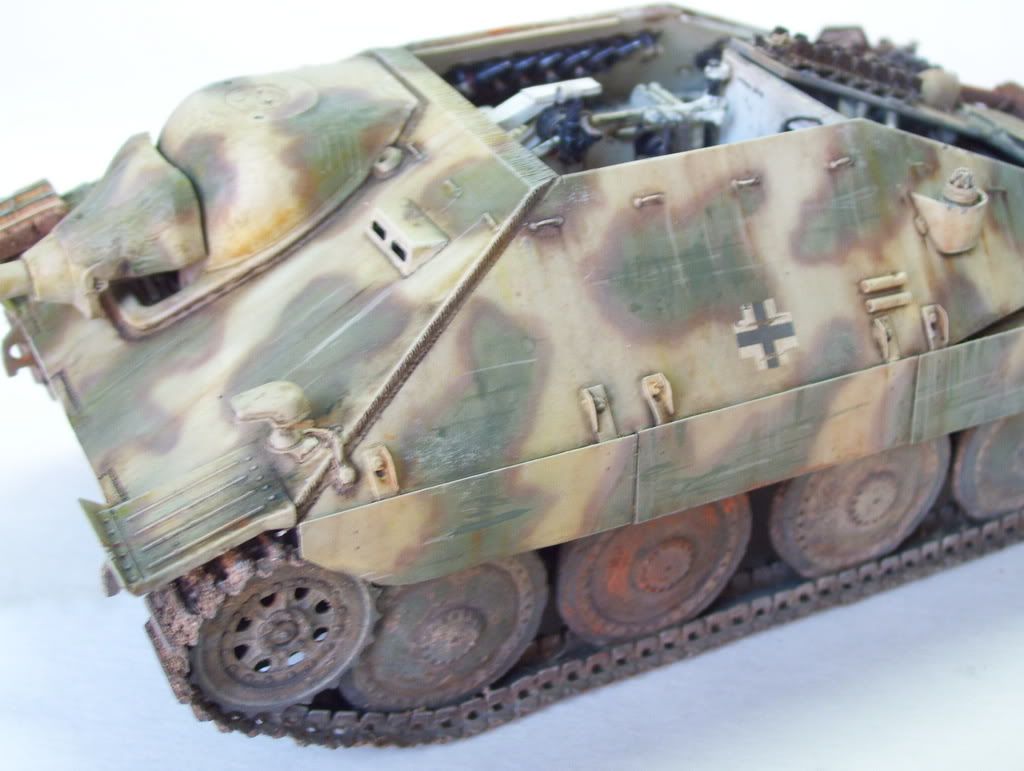
Now, the "chipping" phase: first, my tools: a palette (I've got a million of these tops from General Foods International French Vanilla Cappuchino tins!, a tweezer, a swatch of grey packing foam, and a mix of Testors enamel Steel, raw umber oil, black oil, and orange oil--all the colors you'll ever need!
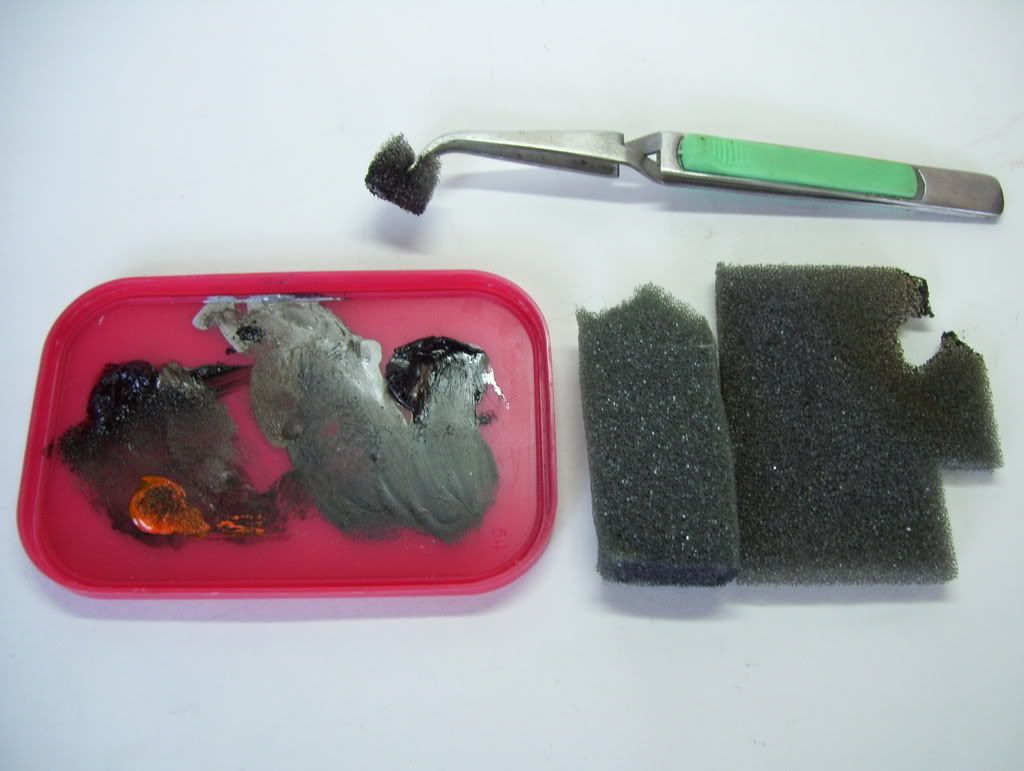
Using the foam, dip it in the mix, and start dabbing the chips alond the edges, the high points, the parts that would ordinarily get dinged up and damaged in real life. It's IMPORTANT to NOT just mindlessly slap the scratches down EVERYWHERE and without thought! You CAN add them in the middle of panels and on flat spots--paint DOES chip and deteriorate in harsh conditions--but try to think about REAL WEAR! I STRONGLY SUGGEST that you go out and photograph and look at construction/landscaping heavy equipment--front end loaders, bulldozers, dump trucks, etc--to see what it really looks like! LESS IS MORE ,if you're in doubt!
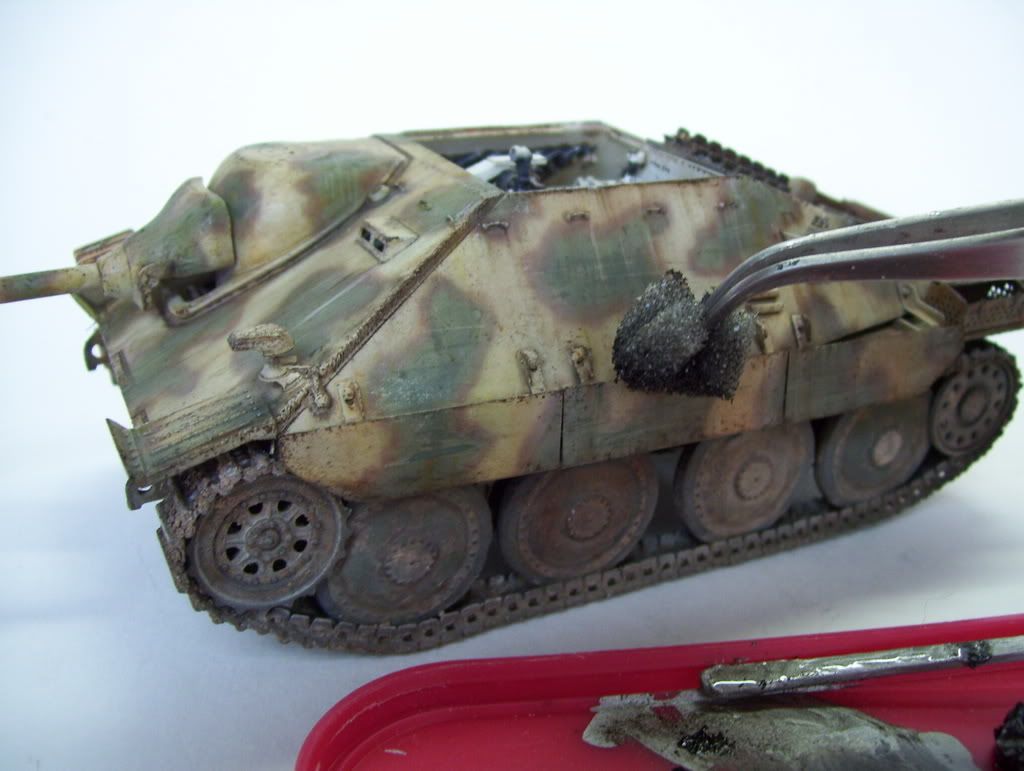
Here's the finished result--notice that the edges have recieved he most abuse. Also note that I put specific scratches with a thin brush in the decals to beat them up a bit. I also have applied more rust/grime streaks coming down from the foliage loops. A light coat of dullcoat was applied to remove any unwanted sheen, and a final, light drybrushing of Testors Silver and Steel was used for very fresh scrapes and scratches.
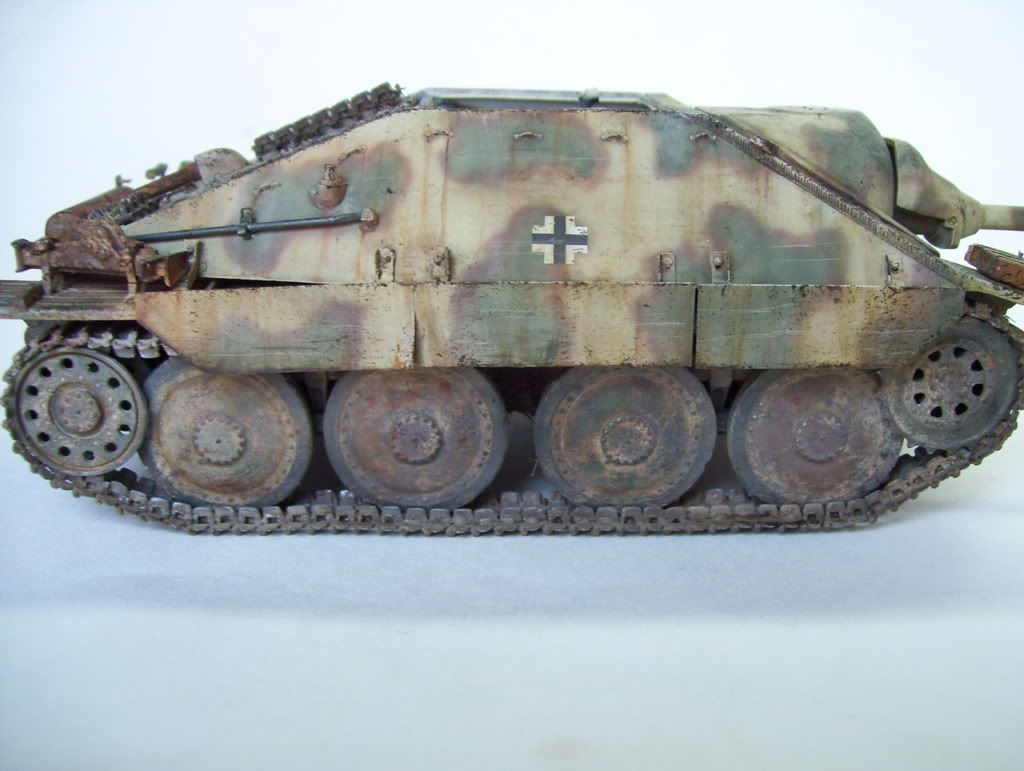
At this point, I applied MIG pigments to the roadwheels and hull, simply by dumping a bit of the pigments into a mixing cup and, with a brush that has been dipped in mineral spirits, I dipped the brush into the powders and just slapped 'em on. Use discretion in doing this--I have found that when they dry, they will lighten up quite a bit, and also reveal more coverage than they looked when wet, when they tend to "disappear" a little bit. Less is more is once again the mantra....in this picture, you can see the results and the final finish...

The last detail was the TASCA star aerial, necessary for he depiction of this Hetzer as a "Befehlspanzer"--a command tank with an extra radio. Here's the kit. The little plastic cone is a jig provided to fold the "star" aerial over; worked like a charm!
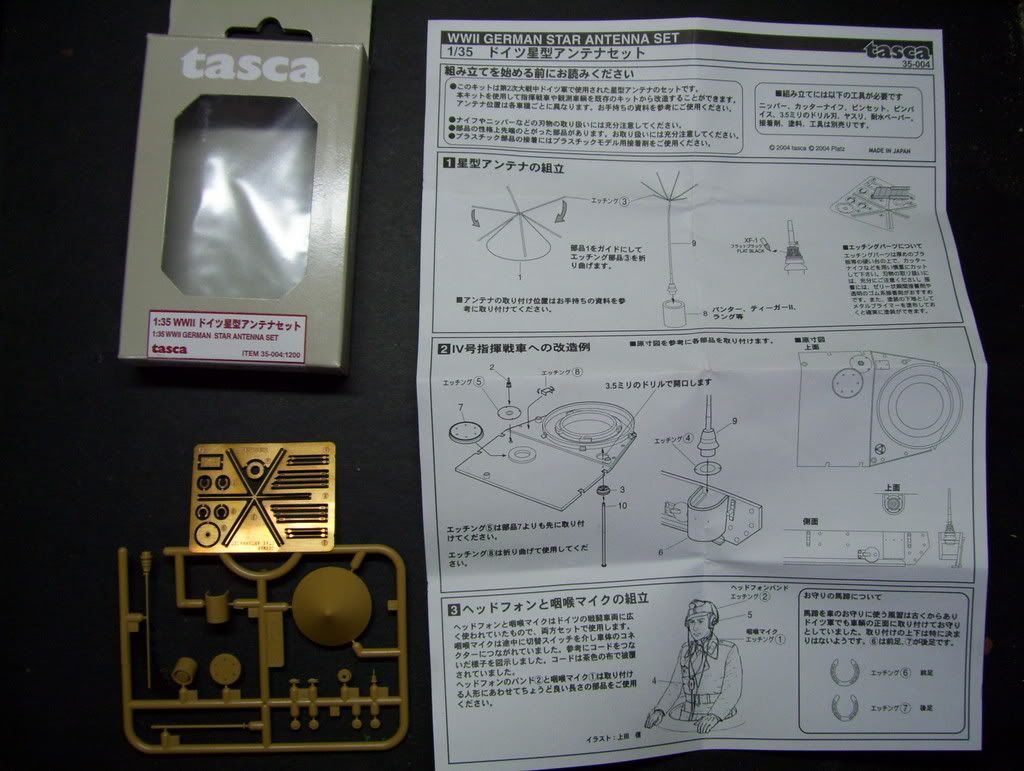
I had originaly used the plastic "post" provided in the TASCA kit as part of the antenna, but after wbill76 pointed out the discrepancy (THANKS, BILL!!)between the spare (mounted there behind the tool box on the side hull) and the plastic part, I corrected the part by using an old guitar string--which was also used for he spare AND the opposite antenna. To make an antenna, get a string--anywhere from .024 to .046, and strip off the outer winding around the core. Save a centimeter or so of winding to simulate the springy "base" of he antenna and drill out the lastic mount with a pin drill and fix the antenna into the hole with gap-filling superglue. Her you can see the difference between the original plastic piece and the corrected guitar string; note the difference in thickness!
Her you can see the difference between the original plastic piece and the corrected guitar string; note the difference in thickness!
The "old" plastic antenna:
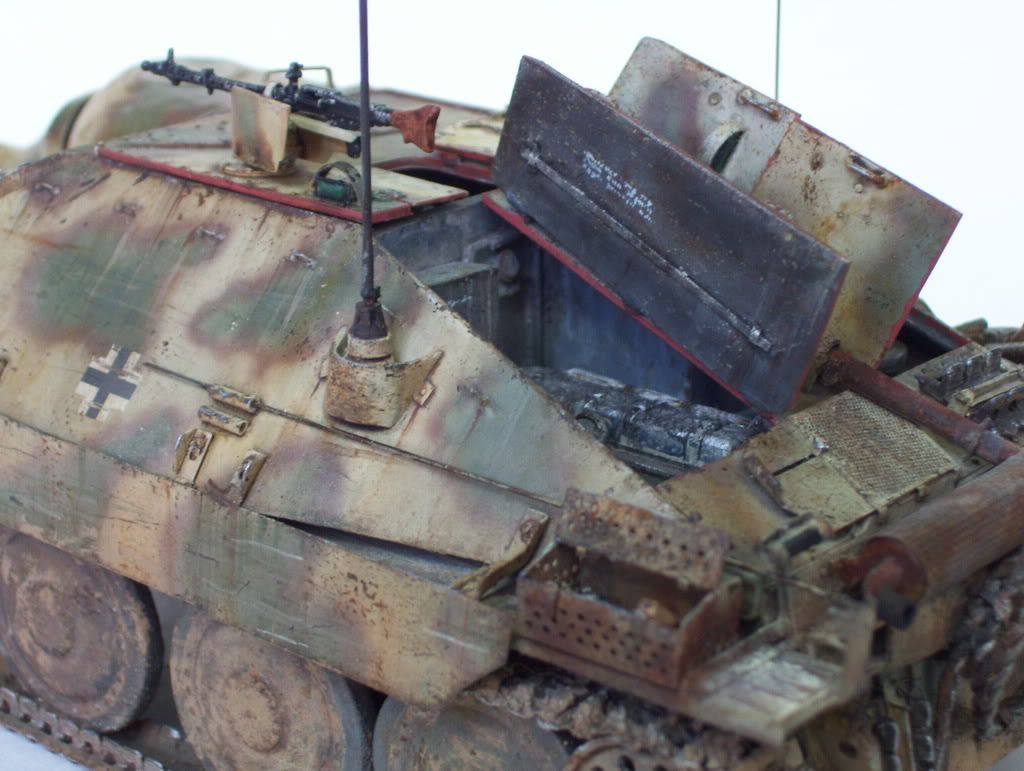
...and the "corrected" guitar string antenna...LISTEN! Can you hear the sustain?...wwwWWWAAAAA! ![Laugh [(-D]](/emoticons/icon_smile_newlaugh.gif)
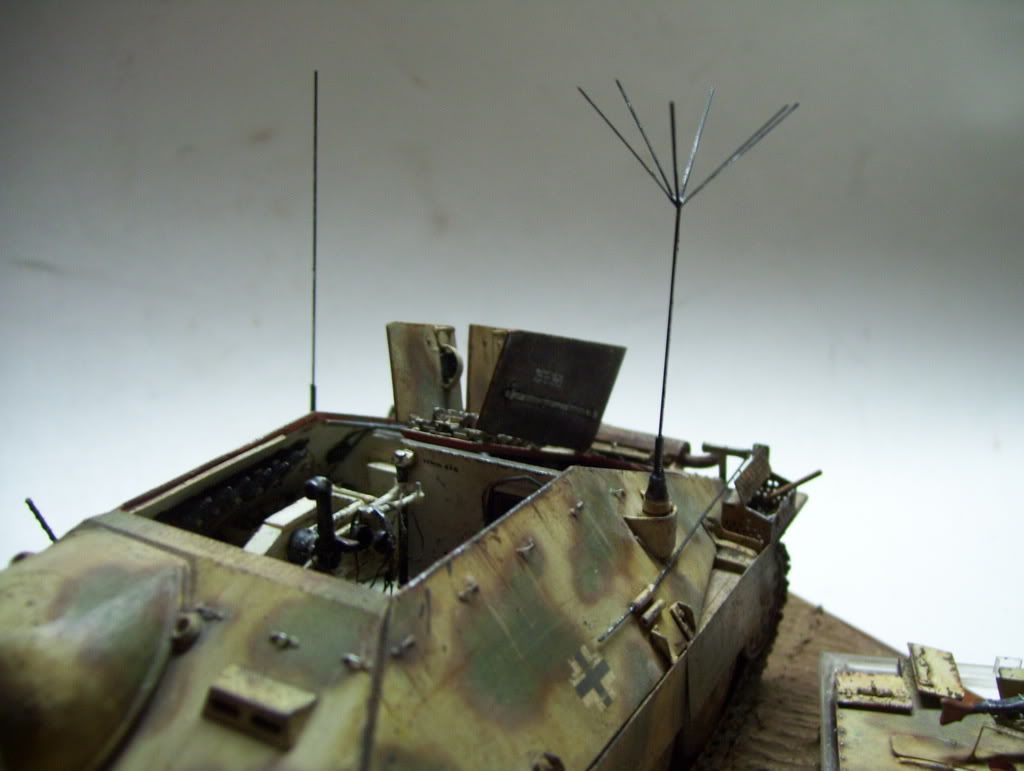
Well, I think that pretty much sums it up! I hope I covered everything clearly enough that you get some ideas and inspiration for our next build! If you have any detailing or finishing questions, be sure to leave me a post here and I'll try to answer them when I get home later tonight from the little lady's house! ![Big Smile [:D]](/emoticons/icon_smile_big.gif) (If I have any energy left!
(If I have any energy left! ![Whistling [:-^]](/emoticons/icon_smile_whistling.gif)
![Laugh [(-D]](/emoticons/icon_smile_newlaugh.gif) )
)
Thanks to all you guys who have inspired me to be a better modeler! I hope that in doing this post, perhaps I can be returning the favor!
*EDIT Nov 25th 2007* You can also find a related tutorial on another Hetzer build which deals with both Silly Putty masking techniques and more "oil dot" wash photos by typing:
Doog's "Silly" Helo Hetzer painting tutorial
...into the"Search" feature of the forums!